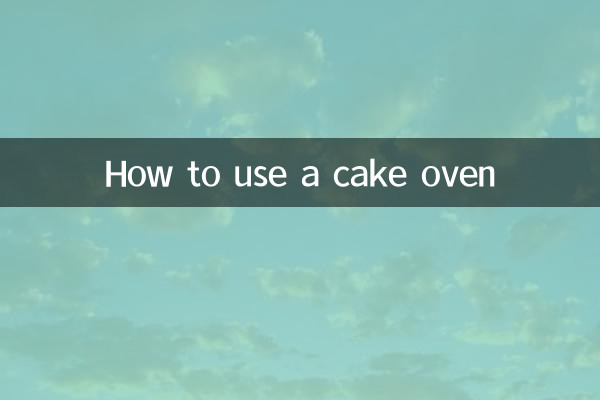How to use a cake oven
In the world of baking enthusiasts, the oven is an indispensable tool for making cakes. Whether you are a beginner or an experienced baker, mastering the correct use of the oven can greatly increase the success rate of cakes. This article will combine the hot topics and hot content on the Internet in the past 10 days to give you a detailed introduction to how to use an oven to make cakes, and attach structured data for reference.
1. Preparation before using the oven

1.Clean the oven: The oven that is used for the first time or has not been used for a long time needs to be cleaned first to avoid residual odor that affects the taste of the cake.
2.Preheat oven: Preheating is a key step in baking. It is usually necessary to adjust the oven to the target temperature 10-15 minutes in advance.
3.Prepare baking pan and molds: Choose a suitable mold according to the type of cake, and grease it or line it with baking paper to prevent it from sticking.
| Oven type | Warm-up time (minutes) | Applicable cake types |
|---|---|---|
| Household desktop oven | 10-15 | Chiffon cake, sponge cake |
| Built-in oven | 5-10 | Cheesecake, mousse cake |
| Wind stove oven | 5-8 | Macaroons, cookies |
2. Oven temperature and time control
Different cakes have greatly different requirements for temperature and time. The following are the baking parameters of recently popular cakes:
| Cake types | Recommended temperature (℃) | Baking time (minutes) | Things to note |
|---|---|---|---|
| Chiffon cake | 150-160 | 40-50 | Do not open the oven door halfway |
| Chocolate Lava Cake | 200-220 | 8-10 | Strictly control time |
| red velvet cake | 170-180 | 25-30 | Need to insert toothpick test |
3. Common problems and solutions when using ovens
Based on recent popular discussions on social platforms, the following high-frequency questions have been sorted out:
1.Cake surface cracked: The temperature is too high or the batter is too thick. It is recommended to lower the temperature by 10-20℃ or adjust the water content of the formula.
2.The bottom of the cake is burnt: Move the baking pan to the middle shelf, or place an empty baking pan on the bottom floor to insulate.
3.Uneven heating: Turn on the hot air circulation function (if available), or rotate the baking pan 180 degrees during baking.
| Problem phenomenon | Possible reasons | solution |
|---|---|---|
| Cake collapses after swelling | Underbaked/opened too early | Extend baking time by 5 minutes |
| Different shades of color | Heating tube aging | Calibrate temperature regularly |
| Has a metallic smell | The new oven is not empty | Burn for 15 minutes before first use |
4. Advanced skills: Use the oven to make creative cakes
Based on recent popular baking trends, the following innovative methods are recommended:
1.Water bath baking: Place the mold in a baking pan filled with hot water, suitable for cheesecakes and other categories that require a moist environment.
2.Sectional temperature control: Set at high temperature (190°C) for the first 15 minutes, then lower the temperature (150°C) for slow baking in the second step.
3.Bake multiple layers at the same time: Use the oven stand to bake 2-3 layers of cake embryos at the same time. Note that each layer needs to leave space for hot air circulation.
5. Oven maintenance tips
1. After each use, wait until the temperature drops below 50°C before cleaning to avoid sudden cooling and sudden heat damage to the inner tank.
2. Use air-burning at 200℃ for 10 minutes to remove oil stains at least once a month. Clean greasy food immediately after baking.
3. The aging of the sealing strip will cause heat loss. If it is found to be damaged, it should be replaced in time.
Master these oven tips and you'll be able to create professional-looking cakes with ease. Remember to fine-tune the parameters according to the characteristics of your own oven. The experience accumulated in practice is the most valuable baking secret!

check the details

check the details